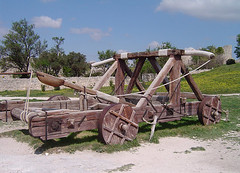 |
If venture capitalists existed in the fifth century BCE, they would have invested in the catapult building enterprise without much thought. Social networking was not the big thing then.
The invention of the catapult had a major impact on ancient warfare and it was assumed that the catapult builders knew the principle behind the steelyard balance. Turns out that the catapult was built around fifth century BCE and Archimedes and other mathematicians of the Hellenistic era (time from Alexander’s death to the defeat of Cleopatra) came up with the theory, some 200 years later.
“They didn’t all go to Plato’s Academy to learn geometry, and yet they were able to construct precisely calibrated devices,” Schiefsky said, adding that craftsmen combined some improvisational trial and error with years of practice to make their machines functional.
The steelyard, which used unequal arms and weights to weigh items, was one device in use well before the advent of the math that explained it. It was a simple case of necessity being the mother of invention, with things like meat needing to be weighed and some method required to do so, Schiefsky said.
Athenians also understood the mechanics behind a basic pulley system well before Archimedes came along and invented the compound pulley, which the Greeks famously used to hoist and topple enemy ships during battles at sea. [Catapults Invented Before Theory Explained Them]
The only help mathematicians provided was to make the catapult more precise so that if an Epicurean wanted to fling a projectile on a Stoic’s head he could do so with precision.
Killer last line.
Ravages, I am glad you got it 🙂 Do you think I have a future in your industry?
A brilliant one at that. Join! Now.